汉学跨文化研究外文文献翻译
- 格式:doc
- 大小:219.50 KB
- 文档页数:23
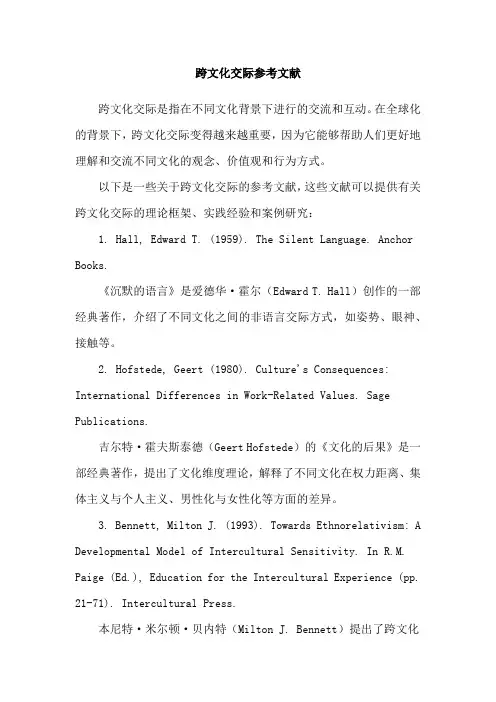
跨文化交际参考文献跨文化交际是指在不同文化背景下进行的交流和互动。
在全球化的背景下,跨文化交际变得越来越重要,因为它能够帮助人们更好地理解和交流不同文化的观念、价值观和行为方式。
以下是一些关于跨文化交际的参考文献,这些文献可以提供有关跨文化交际的理论框架、实践经验和案例研究:1. Hall, Edward T. (1959). The Silent Language. Anchor Books.《沉默的语言》是爱德华·霍尔(Edward T. Hall)创作的一部经典著作,介绍了不同文化之间的非语言交际方式,如姿势、眼神、接触等。
2. Hofstede, Geert (1980). Culture's Consequences: International Differences in Work-Related Values. Sage Publications.吉尔特·霍夫斯泰德(Geert Hofstede)的《文化的后果》是一部经典著作,提出了文化维度理论,解释了不同文化在权力距离、集体主义与个人主义、男性化与女性化等方面的差异。
3. Bennett, Milton J. (1993). Towards Ethnorelativism: A Developmental Model of Intercultural Sensitivity. In R.M. Paige (Ed.), Education for the Intercultural Experience (pp. 21-71). Intercultural Press.本尼特·米尔顿·贝内特(Milton J. Bennett)提出了跨文化敏感度的发展模型,该模型描述了个体从文化固守到文化相对主义的发展过程,有助于理解和培养跨文化交际能力。
4. Gudykunst, William B. (2005). Bridging Differences: Effective Intergroup Communication. Sage Publications.威廉·古迪昆斯特(William B. Gudykunst)的《架起差异:有效的跨团体交际》探讨了不同群体之间的交流和沟通,并提供了一些建议和技巧来改善和增进跨文化交际。
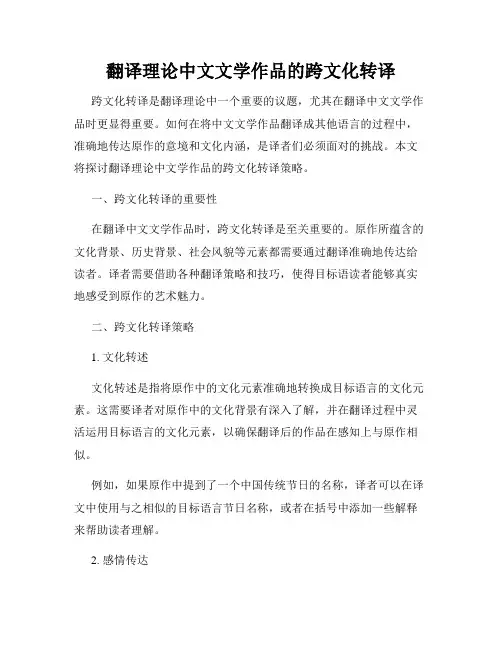
翻译理论中文文学作品的跨文化转译跨文化转译是翻译理论中一个重要的议题,尤其在翻译中文文学作品时更显得重要。
如何在将中文文学作品翻译成其他语言的过程中,准确地传达原作的意境和文化内涵,是译者们必须面对的挑战。
本文将探讨翻译理论中文学作品的跨文化转译策略。
一、跨文化转译的重要性在翻译中文文学作品时,跨文化转译是至关重要的。
原作所蕴含的文化背景、历史背景、社会风貌等元素都需要通过翻译准确地传达给读者。
译者需要借助各种翻译策略和技巧,使得目标语读者能够真实地感受到原作的艺术魅力。
二、跨文化转译策略1. 文化转述文化转述是指将原作中的文化元素准确地转换成目标语言的文化元素。
这需要译者对原作中的文化背景有深入了解,并在翻译过程中灵活运用目标语言的文化元素,以确保翻译后的作品在感知上与原作相似。
例如,如果原作中提到了一个中国传统节日的名称,译者可以在译文中使用与之相似的目标语言节日名称,或者在括号中添加一些解释来帮助读者理解。
2. 感情传达作为文学作品,情感是不可或缺的一部分。
译者在翻译时需要准确地传达原作中的情感,使得目标语读者能够体会到作者的感受。
通过选择合适的词汇和表达方式,译者可以尽力保持原作中的情感色彩。
在翻译情感时,译者要注重选用目标语言中与原作情感相近的词汇,并注意语气、语态等方面的准确表达。
3. 文学特色的保留中文文学作品在形式、格调和文学特色上与其他语言的文学作品有所不同,保留这些独特的文学特色是跨文化转译的重要目标之一。
通过巧妙的句法结构和词汇选择,译者可以在尊重原作风格的基础上,使得目标语译文同样具有一定的文学魅力。
这需要译者在对原作进行理解的基础上,运用恰当的翻译技巧,在转换语言的同时保持文学作品的独特性。
三、翻译实践中的跨文化转译案例下面以一位著名中文小说家的作品为例,来探讨跨文化转译在翻译实践中的应用。
作品《红楼梦》是中国古代文学的经典之作,其深厚的文化底蕴和复杂的情节给翻译带来了很大的挑战。
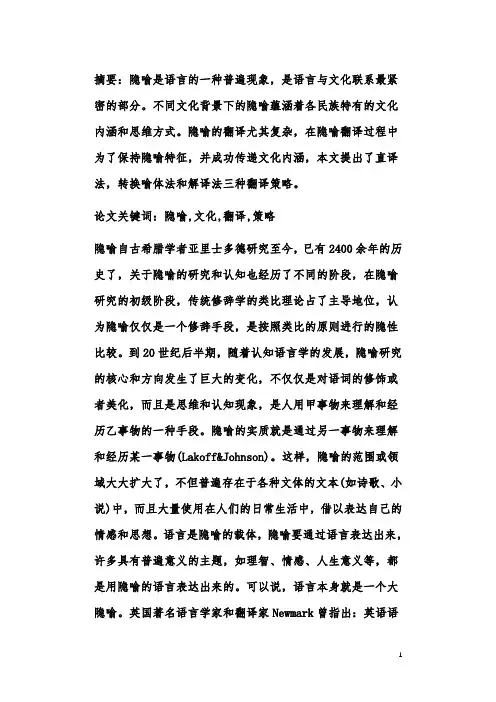
摘要:隐喻是语言的一种普遍现象,是语言与文化联系最紧密的部分。
不同文化背景下的隐喻蕴涵着各民族特有的文化内涵和思维方式。
隐喻的翻译尤其复杂,在隐喻翻译过程中为了保持隐喻特征,并成功传递文化内涵,本文提出了直译法,转换喻体法和解译法三种翻译策略。
论文关键词:隐喻,文化,翻译,策略隐喻自古希腊学者亚里士多德研究至今,已有2400余年的历史了,关于隐喻的研究和认知也经历了不同的阶段,在隐喻研究的初级阶段,传统修辞学的类比理论占了主导地位,认为隐喻仅仅是一个修辞手段,是按照类比的原则进行的隐性比较。
到20世纪后半期,随着认知语言学的发展,隐喻研究的核心和方向发生了巨大的变化,不仅仅是对语词的修饰或者美化,而且是思维和认知现象,是人用甲事物来理解和经历乙事物的一种手段。
隐喻的实质就是通过另一事物来理解和经历某一事物(Lakoff&Johnson)。
这样,隐喻的范围或领域大大扩大了,不但普遍存在于各种文体的文本(如诗歌、小说)中,而且大量使用在人们的日常生活中,借以表达自己的情感和思想。
语言是隐喻的载体,隐喻要通过语言表达出来,许多具有普遍意义的主题,如理智、情感、人生意义等,都是用隐喻的语言表达出来的。
可以说,语言本身就是一个大隐喻。
英国著名语言学家和翻译家Newmark曾指出:英语语言中有3/4是使用隐喻语言。
汉语中使用隐喻的情况也比比皆是,特别是在习语和谚语中。
中国学者刘振前、霍兴花在其论文中也提及:人一生大约使用470万个新颖的隐喻,2140万个定型化的隐喻。
隐喻的频繁使用无疑提高了其在语言学界的地位,引来一波隐喻研究热潮。
语言作为文化的载体,包含着重要的文化信息,是跨文化交际的主要手段。
英语和汉语作为两种截然不同的语言,二者有着不同的文化背景和社会基础,在隐喻使用上也有较大的差异。
这种差异就是隐喻汉英翻译中遇到的难点和重点。
隐喻翻译的关键在于我们能否把汉语隐喻的喻体根据相似点在我们思维中创新,在译文中建立起与原文一致的喻体寓意相似点。
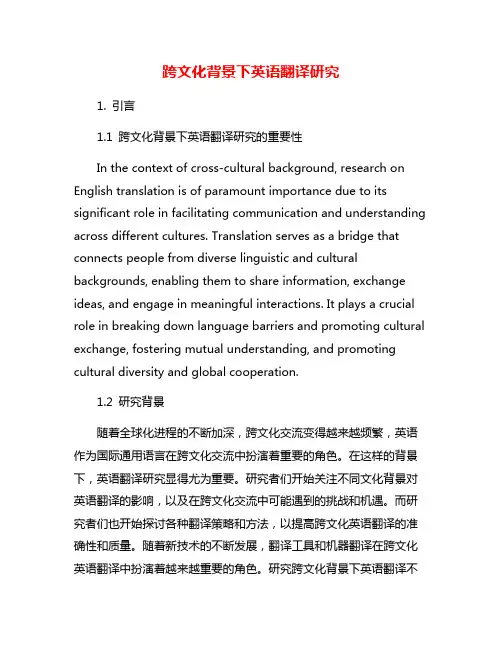
跨文化背景下英语翻译研究1. 引言1.1 跨文化背景下英语翻译研究的重要性In the context of cross-cultural background, research on English translation is of paramount importance due to its significant role in facilitating communication and understanding across different cultures. Translation serves as a bridge that connects people from diverse linguistic and cultural backgrounds, enabling them to share information, exchange ideas, and engage in meaningful interactions. It plays a crucial role in breaking down language barriers and promoting cultural exchange, fostering mutual understanding, and promoting cultural diversity and global cooperation.1.2 研究背景随着全球化进程的不断加深,跨文化交流变得越来越频繁,英语作为国际通用语言在跨文化交流中扮演着重要的角色。
在这样的背景下,英语翻译研究显得尤为重要。
研究者们开始关注不同文化背景对英语翻译的影响,以及在跨文化交流中可能遇到的挑战和机遇。
而研究者们也开始探讨各种翻译策略和方法,以提高跨文化英语翻译的准确性和质量。
随着新技术的不断发展,翻译工具和机器翻译在跨文化英语翻译中扮演着越来越重要的角色。
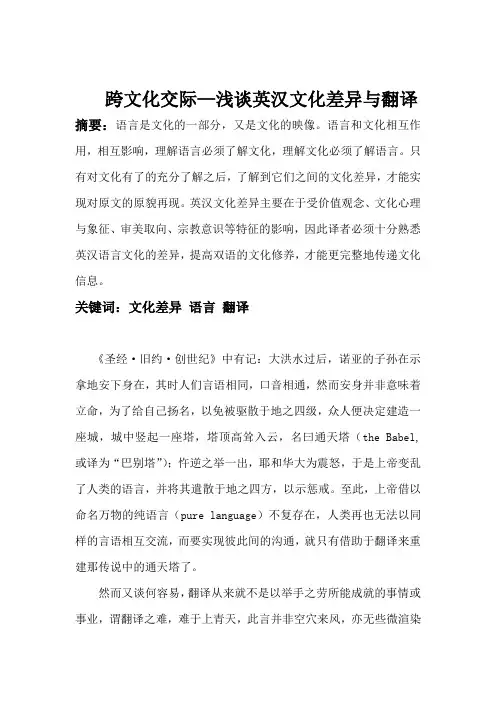
跨文化交际—浅谈英汉文化差异与翻译摘要:语言是文化的一部分,又是文化的映像。
语言和文化相互作用,相互影响,理解语言必须了解文化,理解文化必须了解语言。
只有对文化有了的充分了解之后,了解到它们之间的文化差异,才能实现对原文的原貌再现。
英汉文化差异主要在于受价值观念、文化心理与象征、审美取向、宗教意识等特征的影响,因此译者必须十分熟悉英汉语言文化的差异,提高双语的文化修养,才能更完整地传递文化信息。
关键词:文化差异语言翻译《圣经·旧约·创世纪》中有记:大洪水过后,诺亚的子孙在示拿地安下身在,其时人们言语相同,口音相通,然而安身并非意味着立命,为了给自己扬名,以免被驱散于地之四级,众人便决定建造一座城,城中竖起一座塔,塔顶高耸入云,名曰通天塔(the Babel,或译为“巴别塔”);忤逆之举一出,耶和华大为震怒,于是上帝变乱了人类的语言,并将其遣散于地之四方,以示惩戒。
至此,上帝借以命名万物的纯语言(pure language)不复存在,人类再也无法以同样的言语相互交流,而要实现彼此间的沟通,就只有借助于翻译来重建那传说中的通天塔了。
然而又谈何容易,翻译从来就不是以举手之劳所能成就的事情或事业,谓翻译之难,难于上青天,此言并非空穴来风,亦无些微渲染之嫌,如其不然,英国学界之执牛耳者瑞查兹(I.A.Richards)当年概不至于作如下感发:在宇宙演化过程中,翻译堪称最为复杂之事件,亦未可知。
语言是意义的载体,因此要完整的把一国语言翻译为另一国语言,译者则必须了解这两国的双语文化知识。
不同的语言转换必须服从特定的文化要求,翻译不仅是语言的转换,更是文化信息的传递,语言的转换只是翻译的表层,而文化信息的传递才是翻译的实质。
因此,要更深刻,更贴切地传递原文的内在信息,译者必须探明英汉双语的文化特征及其差异,并将双语的文化内涵适当对接,真实地再现原文的面貌。
由此可见,译者的双语文化知识在其成功的翻译中起着决定性作用。

跨文化背景下英语翻译研究随着全球化的发展,跨文化交流日益频繁,翻译作为不同语言间的桥梁起着至关重要的作用。
特别是英语作为全球通用语言,其翻译研究更是备受关注。
跨文化背景下的英语翻译研究涵盖了许多领域,如文学、商务、法律等,对于增进不同文化之间的理解和交流有着重要意义。
本文将从跨文化背景下英语翻译的重要性、挑战和研究成果等方面进行探讨。
二、跨文化背景下英语翻译的挑战在跨文化背景下进行英语翻译面临着许多挑战。
首先是语言的差异性,不同语言间的语法、词汇、句式等存在较大差异,翻译者需要克服语言障碍,保持翻译的准确性和自然流畅性。
其次是文化的差异性,不同文化之间存在着不同的文化习惯、信仰、价值观等,翻译者需要全面理解不同文化的内涵和外延,做到恰如其分地翻译。
随着科技的发展,新兴词汇和概念不断涌现,翻译者需要不断更新知识和技能,以应对翻译过程中的各种挑战。
为了应对跨文化背景下英语翻译的挑战,研究者开展了大量的翻译研究,取得了诸多成果。
在翻译理论和方法方面,研究者提出了一系列翻译模型和原则,如功能对等理论、文化转换理论、合作原则等,为跨文化翻译提供了理论指导和实践方法。
在翻译技术和工具方面,随着机器翻译和计算机辅助翻译技术的发展,研究者不断改进和创新翻译工具,提高翻译效率和质量。
跨文化背景下的英语翻译研究还涉及到文学翻译、商务翻译、法律翻译等领域,为不同领域的跨文化交流提供了专业化的翻译服务和支持。
四、结语跨文化背景下英语翻译研究具有重要的现实意义和深远的影响。
随着全球化的发展,跨文化交流将更加频繁和密切,英语翻译将发挥越来越重要的作用。
研究者需要不断深化跨文化翻译理论和方法,提高翻译技术水平,为促进全球文化交流和理解做出更大的贡献。
翻译人员需要不断提升自身的专业素养和跨文化交际能力,为翻译工作提供更加有力的支持和保障。
相信在不久的将来,跨文化背景下英语翻译研究将取得更多的突破和进展,为推动全球文化交流和繁荣做出更大的贡献。
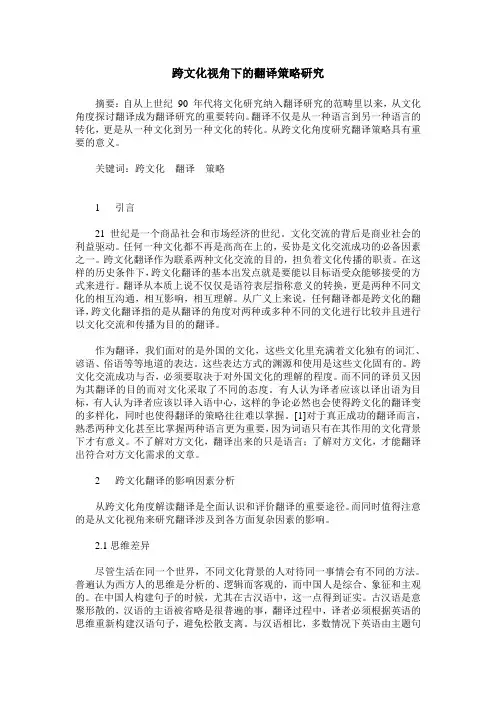
跨文化视角下的翻译策略研究摘要:自从上世纪90 年代将文化研究纳入翻译研究的范畴里以来,从文化角度探讨翻译成为翻译研究的重要转向。
翻译不仅是从一种语言到另一种语言的转化,更是从一种文化到另一种文化的转化。
从跨文化角度研究翻译策略具有重要的意义。
关键词:跨文化翻译策略1 引言21世纪是一个商品社会和市场经济的世纪。
文化交流的背后是商业社会的利益驱动。
任何一种文化都不再是高高在上的,妥协是文化交流成功的必备因素之一。
跨文化翻译作为联系两种文化交流的目的,担负着文化传播的职责。
在这样的历史条件下,跨文化翻译的基本出发点就是要能以目标语受众能够接受的方式来进行。
翻译从本质上说不仅仅是语符表层指称意义的转换,更是两种不同文化的相互沟通,相互影响,相互理解。
从广义上来说,任何翻译都是跨文化的翻译,跨文化翻译指的是从翻译的角度对两种或多种不同的文化进行比较并且进行以文化交流和传播为目的的翻译。
作为翻译,我们面对的是外国的文化,这些文化里充满着文化独有的词汇、谚语、俗语等等地道的表达。
这些表达方式的渊源和使用是这些文化固有的。
跨文化交流成功与否,必须要取决于对外国文化的理解的程度。
而不同的译员又因为其翻译的目的而对文化采取了不同的态度。
有人认为译者应该以译出语为目标,有人认为译者应该以译入语中心,这样的争论必然也会使得跨文化的翻译变的多样化,同时也使得翻译的策略往往难以掌握。
[1]对于真正成功的翻译而言,熟悉两种文化甚至比掌握两种语言更为重要,因为词语只有在其作用的文化背景下才有意义。
不了解对方文化,翻译出来的只是语言;了解对方文化,才能翻译出符合对方文化需求的文章。
2 跨文化翻译的影响因素分析从跨文化角度解读翻译是全面认识和评价翻译的重要途径。
而同时值得注意的是从文化视角来研究翻译涉及到各方面复杂因素的影响。
2.1思维差异尽管生活在同一个世界,不同文化背景的人对待同一事情会有不同的方法。
普遍认为西方人的思维是分析的、逻辑而客观的,而中国人是综合、象征和主观的。
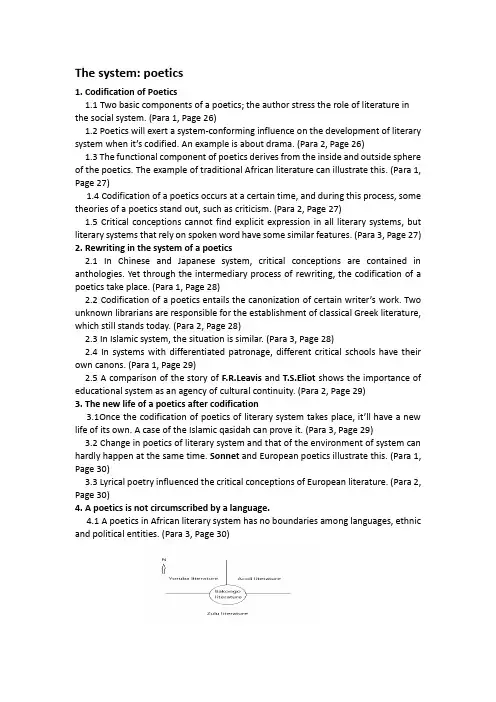
The system: poetics1. Codification of Poetics1.1 Two basic components of a poetics; the author stress the role of literature in the social system. (Para 1, Page 26)1.2 Poetics will exert a system-conforming influence on the development of literary system when it’s codified. An example is about drama. (Para 2,Page 26)1.3 The functional component of poetics derives from the inside and outside sphere of the poetics. The example of traditional African literature can illustrate this. (Para 1, Page 27)1.4 Codification of a poetics occurs at a certain time, and during this process, some theories of a poetics stand out, such as criticism. (Para 2, Page 27)1.5 Critical conceptions cannot find explicit expression in all literary systems, but literary systems that rely on spoken word have some similar features. (Para 3, Page 27)2. Rewriting in the system of a poetics2.1 In Chinese and Japanese system, critical conceptions are contained in anthologies. Yet through the intermediary process of rewriting, the codification of a poetics take place. (Para 1, Page 28)2.2Codification of a poetics entails the canonization of certain writer’s work. Two unknown librarians are responsible for the establishment of classical Greek literature, which still stands today. (Para 2, Page 28)2.3 In Islamic system, the situation is similar. (Para 3, Page 28)2.4 In systems with differentiated patronage, different critical schools have their own canons. (Para 1, Page 29)2.5 A comparison of the story of F.R.Leavis and T.S.Eliot shows the importance of educational system as an agency of cultural continuity. (Para 2, Page 29)3. The new life of a poetics after codification3.1Once the codification of poetics of literary system takes place, it’ll have a new life of its own. A case of the Islamic qasidah can prove it. (Para 3, Page 29)3.2 Change in poetics of literary system and that of the environment of system can hardly happen at the same time. Sonnet and European poetics illustrate this. (Para 1, Page 30)3.3 Lyrical poetry influenced the critical conceptions of European literature. (Para 2, Page 30)4. A poetics is not circumscribed by a language.4.1 A poetics in African literary system has no boundaries among languages, ethnic and political entities. (Para 3, Page 30)4.2 The Islamic system is constrained by common ideology. (Para 1, Page 31)4.3 Islamic poetics was adopted by other languages and cause some effects. (Para 2, Page 31)4.4 The similarity between Islamic and European systems is striking. (Para 3, Page 31)4.5 The functional component of European poetics is easily ignored by relatively few readers. (Para 1, Page 32)4.6 The success of Romanticism (the functional component of poetics). (Para 2, Page 32)4.7 Further evidence of poetics not being circumscribed by a language. (Para 3, Page 32)5. Rewriting seems to a good way deal with the problems concerning with poetics.5.1Two components of the poetics behave differently under the direct influence from the environment. (Para 1, Page 33)5.2 Particular themes dominate certain periods in the evolution of a system. (Para 1, Page 34)5.3 Innovative and conservative influence generated by the two components of a poetics. (Para 2, Page 34)5.4 Epic and ballad (Para 1, Page 35)5.5 Poetics is a historical variable and not absolute. (Para 2, Page 35)5.6 One way is to keep the absolute position of poetics. (Para 3, Page 35)5.7 The rhyme and meter rule reigned supreme.(Para 1, Page 36)5.8 Rewriting can be judged differently at various stages in the evolution of a literary system. (Para 2, Page 36)5.9 People’s review on Pound’s poems. (Para 1, Page 37)5.10 History is made by people. (Para 2, Page 37)5.11How can literary system maintain a “steady state”? (Para 1, Page 38)5.12 Rewritten literature plays a vital part. (Para 2, Page 38)5.13Rewriting deeply affect the interpenetration of literary systems. (Para 3, Page 38)6. Translation is not only a linguistic consideration but also a ideological one .6.1 Literary histories have had little time for translations. (Para 1, Page 39)6.2 A poem should be recreated in the same meter. (Para 2, Page 39)6.3 The creation of words bears out the same proposition. (Para 3, Page 39)。
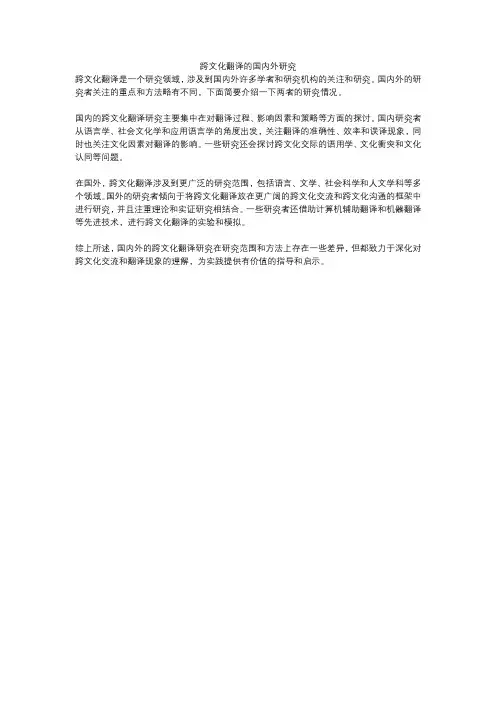
跨文化翻译的国内外研究
跨文化翻译是一个研究领域,涉及到国内外许多学者和研究机构的关注和研究。
国内外的研究者关注的重点和方法略有不同,下面简要介绍一下两者的研究情况。
国内的跨文化翻译研究主要集中在对翻译过程、影响因素和策略等方面的探讨。
国内研究者从语言学、社会文化学和应用语言学的角度出发,关注翻译的准确性、效率和误译现象,同时也关注文化因素对翻译的影响。
一些研究还会探讨跨文化交际的语用学、文化衝突和文化认同等问题。
在国外,跨文化翻译涉及到更广泛的研究范围,包括语言、文学、社会科学和人文学科等多个领域。
国外的研究者倾向于将跨文化翻译放在更广阔的跨文化交流和跨文化沟通的框架中进行研究,并且注重理论和实证研究相结合。
一些研究者还借助计算机辅助翻译和机器翻译等先进技术,进行跨文化翻译的实验和模拟。
综上所述,国内外的跨文化翻译研究在研究范围和方法上存在一些差异,但都致力于深化对跨文化交流和翻译现象的理解,为实践提供有价值的指导和启示。
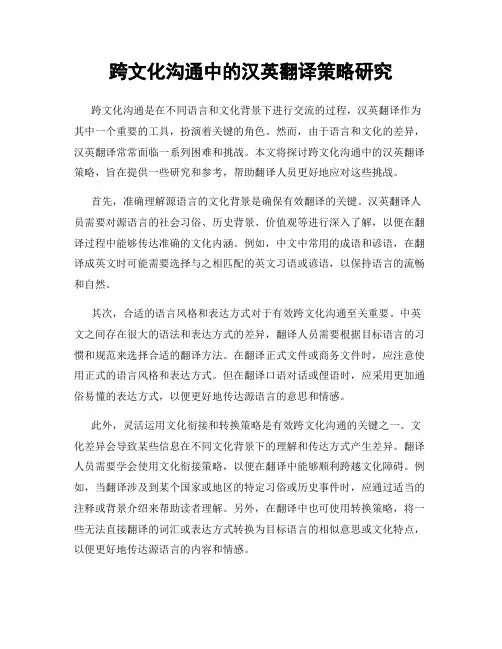
跨文化沟通中的汉英翻译策略研究跨文化沟通是在不同语言和文化背景下进行交流的过程,汉英翻译作为其中一个重要的工具,扮演着关键的角色。
然而,由于语言和文化的差异,汉英翻译常常面临一系列困难和挑战。
本文将探讨跨文化沟通中的汉英翻译策略,旨在提供一些研究和参考,帮助翻译人员更好地应对这些挑战。
首先,准确理解源语言的文化背景是确保有效翻译的关键。
汉英翻译人员需要对源语言的社会习俗、历史背景、价值观等进行深入了解,以便在翻译过程中能够传达准确的文化内涵。
例如,中文中常用的成语和谚语,在翻译成英文时可能需要选择与之相匹配的英文习语或谚语,以保持语言的流畅和自然。
其次,合适的语言风格和表达方式对于有效跨文化沟通至关重要。
中英文之间存在很大的语法和表达方式的差异,翻译人员需要根据目标语言的习惯和规范来选择合适的翻译方法。
在翻译正式文件或商务文件时,应注意使用正式的语言风格和表达方式。
但在翻译口语对话或俚语时,应采用更加通俗易懂的表达方式,以便更好地传达源语言的意思和情感。
此外,灵活运用文化衔接和转换策略是有效跨文化沟通的关键之一。
文化差异会导致某些信息在不同文化背景下的理解和传达方式产生差异。
翻译人员需要学会使用文化衔接策略,以便在翻译中能够顺利跨越文化障碍。
例如,当翻译涉及到某个国家或地区的特定习俗或历史事件时,应通过适当的注释或背景介绍来帮助读者理解。
另外,在翻译中也可使用转换策略,将一些无法直接翻译的词汇或表达方式转换为目标语言的相似意思或文化特点,以便更好地传达源语言的内容和情感。
除此之外,注意文化的敏感性和尊重也是跨文化沟通中的重要考虑因素。
翻译人员应尽量避免使用带有贬低或歧视性的词汇和表达方式,以免引起误解和冲突。
在翻译与文化相关的内容时,应尊重目标语言的文化习惯和经验,不应强加自己的文化观念和价值观。
同时,应避免在翻译中引入政治话题或争议性问题,以免触发负面情绪和纠纷。
最后,不断学习和提升自己的翻译技巧和跨文化沟通能力也是至关重要的。
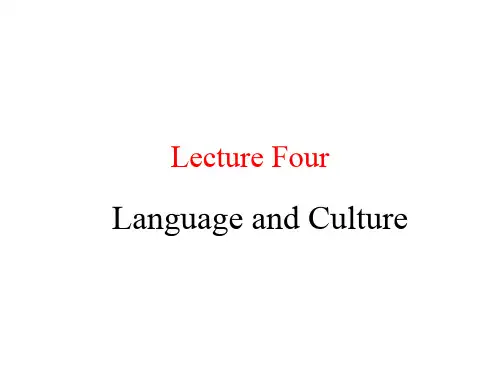
浅谈跨文化视角下英语电影名汉译方法浅谈跨文化视角下英语电影名汉译方法引言随着全球化的进程,电影作为一种跨文化传媒形式,越来越普及且受到人们的喜爱。
在电影的翻译方面,片名的汉译成为了一项重要的工作。
本文旨在通过跨文化的视角,探讨英语电影名在汉译过程中所面临的问题,并提出一些翻译方法。
一、英语电影名的特点英语电影名通常由片名和副标题两部分组成,挑选副标题的目的是为了进一步凸显电影的主题和目标受众。
英语电影名具有以下几个特点:1.简洁明了:英语电影名通常由几个英文单词或短语组成,能够简明地传达电影的主题和情感。
2.多样性:英语电影名涵盖了各种类型的片子,有喜剧、爱情、动作片等,每个类型都有其独特的特点。
3.词语双关:为了吸引观众的注意力,英语电影名常常使用双关语、讽刺等修辞手法来展示电影的独特之处。
二、英语电影名汉译的问题在将英语电影名翻译成中文时,翻译者面临以下几个问题:1.语言障碍:英汉两种语言之间存在很大的差异,因此在翻译过程中容易出现语言难以表达的情况。
2.文化差异:英语电影名通常是基于西方文化和价值观设计的,而中文观众对于这些文化和价值观的理解可能存在差异。
因此,在汉译时需要考虑到中文观众对电影名的理解和接受水平。
3.传达主题:英语电影名不仅是为了吸引观众的注意力,还要准确传达电影的主题和情感。
在翻译时,需要注重保持原电影名的情感和内涵。
三、英语电影名汉译的方法1.音译法音译法是将英语电影名中的单词或短语直接音译成相应的中文词语。
这种翻译方法简单且忠实于原意,能够保留电影名的风格和形象。
同时,由于音译法存在一定的文化差异,因此需要考虑到中文观众对电影名的理解和接受水平。
例如,电影《Avatar》在中国被翻译为《阿凡达》,该译名直接音译了英语片名,并且注重了音译词语在中国文化中的含义。
2.意译法意译法是将英语电影名中的单词或短语按照其意义进行翻译。
这种翻译方法可以更好地传达电影的主题和情感,同时也能够让中文观众更好地理解和接受电影名。
论跨文化翻译在汉英文化翻译中的应用作者:蒋勇来源:《群文天地》2011年第24期文章从文化翻译观的角度,分析了文化翻译,即对原语中各种文化信息的处理。
翻译中文化缺失,是跨文化交际中常见的现象,文化缺失往往会造成翻译中的困难和失误,这要求翻译者要精通原语和译语,还要熟悉中英文文化,从而提出跨文化翻译的策略。
一、引言“山寨”一词,源于广东话,是一种由民间IT力量发起的产业现象。
其主要表现为仿造性、快速化、平民化。
主要表现形式为通过小作坊起步,快速模仿成名品牌,涉及手机、数码产品、游戏机等不同领域。
这种文化的另一方面则是善打擦边球,经常行走在行业政策的边缘,引起争议。
目前,“山寨”这一说法,已经进入百姓日常生活及话语,各种媒体对于山寨现象的报道也此起彼伏,在汉英翻译时,“山寨”的对应英文版本多种多样:新华网在2009年12月的文章中翻译为copycat,美国CNN在报道中国的山寨手机时用的是bandit phones,还见到有knock-off,pirated,fake等译文,而在说到山寨经济时,知网翻译助手译为village economy,而谷歌翻译工具译成cottage economy。
虽然汉语中早有山寨,但是山寨原指山林中设有防守栅栏的地方,也指有寨子的山村,引伸为绿林好汉在山中的营寨。
山寨行为,则指的是个人或团体对知名事物的粗陋模仿与改动而又自成一体。
央视经典节目《正大综艺》推出了一个新板块——逗你玩。
这使我们不禁想起著名表演艺术家、相声“泰斗” 马三立的相声《逗你玩》,听起这个相声段子让人笑声不断。
《正大综艺》中的“逗你玩”也是一个娱乐性的栏目,演员的夸张的眼神和手势,幽默的动作和情节的选择,生活中的细节,通过夸张和演示的完美结合,呈现给观众的是一种笑口常开和一周之后的舒服和惬意。
但是板块片头中英文原文的名称为oops,这和汉语中的“逗你玩”的差别还是很大的。
Oops一词, OALD Seventh edition 中有两个释义(1)used when sb has almost had an accident, broken sth, etc (2)used when you have done sth embarrassing, said sth rude by accident, told a secret, etc;陆谷孙教授主编的《英汉大词典》中的释义为“哎哟;哎哟,对不起”。
跨文化交际英文文献1. Ting-Toomey, S., & Oetzel, J. G. (2003). Managing intercultural conflict effectively. Sage Publications.This book explores the challenges of intercultural communication and provides strategies for effectively managing and resolving conflicts that arise in cross-cultural interactions.2. Samovar, L. A., Porter, R. E., & McDaniel, E. R. (2014). Communication between cultures. Cengage Learning.This comprehensive textbook covers various aspects of intercultural communication, including cultural differences in verbal and nonverbal communication, cultural values and norms, and strategies for successful cross-cultural interaction.3. Lustig, M. W., & Koester, J. (2013). Intercultural competence: Interpersonal communication across cultures. Pearson.Written by leading experts in the field, this book explores the concept of intercultural competence and provides practical guidance for developing effective communication skills in multicultural settings.4. Jandt, F. E. (2015). An introduction to intercultural communication: Identities in a global community. Sage Publications.This introductory textbook provides an overview of intercultural communication theories and concepts, as well as case studies andreal-life examples to illustrate the challenges and opportunities of cross-cultural communication.5. Gudykunst, W. B., & Kim, Y. Y. (2019). Communication in everyday life: A survey of communication. Taylor & Francis.This comprehensive survey of intercultural communication examines various aspects of communication in everyday life, including communication styles, cultural variations in communication practices, and the impact of globalization on intercultural communication.These references provide a good starting point for researching the topic of intercultural communication in English.。
transcultural studies名词解释嘿,朋友!您知道啥是“跨文化研究”(transcultural studies)不?这可是个相当有趣且重要的概念呢!简单来说,跨文化研究就像是一座连接不同文化世界的桥梁。
您想想,世界上有那么多各种各样的文化,就像一个个独立的小王国,有着自己独特的规则、价值观和行为方式。
跨文化研究呢,就是要深入探究这些不同文化之间的差异和相似之处。
比如说,为什么有些地方的人见面喜欢拥抱,而有些地方的人则喜欢鞠躬?为啥有的文化里红色代表喜庆,而在另一些文化中却有不同的含义?这就好像在一个巨大的文化拼图中,努力寻找每一块之间的关联和区别。
它可不只是简单地比较不同文化的表面现象哦!那得深入到文化的内核,了解其背后的历史、社会、经济等诸多因素。
就好比我们要了解一棵树,不能只看它的枝叶,还得研究它的根、树干和生长环境。
跨文化研究也像是一个超级侦探,要揭开文化现象背后隐藏的秘密。
比如,某种传统习俗是怎么形成的?它在不同的时代又有怎样的变化?这难道不是很神奇吗?您再想想,如果没有跨文化研究,我们可能会对其他文化产生误解和偏见。
就好像闭着眼睛走在陌生的路上,很容易摔跤。
但有了跨文化研究,我们就能睁开眼睛,看清前方的道路,更加理解和尊重其他文化。
举个例子,假如一个外国朋友不理解咱们春节为什么要放鞭炮,通过跨文化研究,我们就能给他讲清楚这背后蕴含的驱邪迎福的美好愿望,还有悠久的历史传承。
这不就增进了彼此的了解和友谊嘛!跨文化研究还能帮助我们在全球化的时代更好地交流与合作。
现在世界越来越像一个地球村,不同文化背景的人在一起工作、生活的机会越来越多。
如果不了解彼此的文化,那不是很容易产生冲突和矛盾?所以啊,跨文化研究就像是一把打开文化宝藏的钥匙,让我们能够在丰富多彩的文化世界中畅游,收获知识、理解和包容。
总之,跨文化研究是一门非常有意义和价值的学问,它让我们的世界变得更加多元、丰富和和谐。
跨文化交际与翻译Intercultural communication and translation Intercultural communication mainly refers to the communication between the native speakers and non-native speakers, as well as the communication between people who differ in any aspect of language or culture background. Due to the differences in surroundings, societies and religions of different ethnic groups, each language community results in its own code of language, social culture, customs and practices and so on. Intercultural communication studies situations when people from different culture backgrounds interact. Aside from language, IC focuses on social attributes, thought patterns and the cultures of different groups of people. IC also involves understanding the different cultures, languages and customs of people from other countries. There are three formats of IC: interracial communication (when source and receiver are different races), interethnic communication (situation in which the parties are of the same race but of different ethnic origins) and intracultural communication (communication between members of the same culture including racial, ethnic and other co-cultures).The term translation itself has several meanings: it can refer to the general subject field, the product (the text that has been translated) or the process (the act of producing the translation, otherwise known as translating). The process of translating between two different written languages involves the translator changing an original written text (the source text) in the original verbal language (the source language) into a written text (the target text) in a different verbal language (the target language). This type corresponds to “interlingual translation” and is oneof the three Roman Jakobson in his seminal paper. Jakobson’s categories are: 1. Intralingual translation, or “rewording”– an interpretation of verbal signs by means of other signs of the same language; 2. Interlingual translation, or “translation proper”–an interpretation of verbal signs by means of some other language; 3. Intersemiotic translation, or “transmutation”– an interpretation of verbal signs by means of signs of non-verbal sign systems. Intralingual translation would occur when we rephrase an expression or text in the same language to explain or clarify something we might have said or written. Intersemiotic translation would occur if a written text were translated, for example, into music, film or painting. It is interlingual translation which is the traditional, although by no means exclusive, focus of translation studies.It is easily seen that the three forms of intercultural communication and the three types of translation are partly corresponding to each other, especially interracial communication and interlingual translation which both attach attention on the communication between native and non-native, and where different cultures of different countries play more important role. To conduct effective intercultural communication, one has to understand the differences between the different nations and then to look for them and pay attention to in every cross-cultural communication situation. By doing this, the high-context communicators can learn to use and respond words, emotions, postures differently, and low-context communicators can learn topay attention to context and learn to interpret meaning in terms of the context. It is evident that different countries or nations have quite different customs, cultures, ways to expressemotions and so on, to become successful communicator and avoid serious culture shock and failure, it’s essential to have intercultural knowledge about low context, high context, power distance and other information, to eradicate stereotypes, to hold placid attitude, to know that cultures are different.And there was no doubting translation is an intercultural activity. The culture of source text can only find echoes from source language readers, however, for target language readers, the lack of similar cultural background may lead to the loss of ingenuity of the originals. Translation as a tool of communication is thus a significant intercultural activity aiming at breaking the language and culture barriers and enriching communication. To become a successful translator or interpreter, learning culture difference is an inevitable aspect of training. Translation texts are the product of the mutual influence of source language culture and target language culture. The properties, extent and concrete level of the two languages and cultures are to some degree influencing the choice of translation strategies, syntactic structures and words of the translators. Thus culture as a dispensable capability of a translator, of conducting effective translation makes translation resemble to intercultural communication.Effective intercultural communication cannot be accomplished at one stroke, and it is impossible to do successful translation without knowledge of cultures. To stride across the cultural barriers of different nati ons, it’s necessary to adjust the attitude of intercultural communication, and recognize the discrepancy of translation strategies, so to reconstruct the artistic sense of originals, and appeal to more target readers with vigorous translation. Knowing better the relationship betweenintercultural communication and translation is of great importance to these two practices.。
古代文献翻译与跨文化交流研究古代文献是我们了解历史的重要途径,而翻译这些文献则是让不同国家、不同文化之间进行交流的桥梁。
因此,古代文献翻译与跨文化交流研究显得尤为重要。
古代文献的翻译,首先需要考虑的是语言的难点。
古代文献往往使用的是古代语言,语法、词汇等都与现代语言存在巨大差异。
因此,翻译人员需要具备扎实的语言功底,能够准确理解原文的含义,并将其转化为现代语言。
此外,还需要考虑到原文背后所蕴含的文化内涵,避免出现过度简化或误解的情况。
在跨文化交流方面,古代文献的翻译起到了至关重要的作用。
通过翻译,不同国家、不同文化之间可以更好地了解彼此的历史、文化和思想。
例如,中国的《论语》、《道德经》等经典著作被翻译成多种语言,在全球范围内传播中国传统文化,增进了不同民族之间的相互了解和友谊。
同时,古代文献的翻译也促进了不同国家之间的学术交流。
在学术界中,许多重要的学术成果都是通过对古代文献的研究而得出的。
例如,中国的《黄帝内经》、《伤寒杂病论》等医学经典被翻译成多种语言,在国际上推动了中医药的发展和传播。
当然,在进行古代文献翻译和跨文化交流时,也存在着一些挑战和困难。
例如,不同国家、不同文化之间存在着巨大的历史和文化差异,这就需要翻译人员具备深厚的跨文化素养,在进行翻译时能够准确地把握不同文化之间的差异和联系。
此外,由于古代文献往往存在着多种版本和不同解释,因此需要进行深入的研究和分析,确保翻译的准确性和权威性。
总之,古代文献翻译与跨文化交流研究是一个复杂而丰富的领域。
通过这项工作,我们可以更好地了解不同国家、不同文化之间的历史和思想,促进不同民族之间的相互了解和友谊,同时也推动了学术交流和文化传承。
汉学跨文化研究外文翻译英文Sinology: Chinese Intellectual History and Transcultural StudiesPablo Blitstein, Ruprecht HeidelbergThe guest editors of this journal issue have kindly asked me to provide a short overview of the relation between transcultural studies and Chinese intellectual history in Euro-American academia. There was a certain risk in accepting this request, as it might be either too small or too big a task. It would be too small if I narrowed it down to a review of explicit references to transcultural studies within Chinese intellectual history; but it would be too big if I extended it to a study of all the questions, approaches, and methods that the two fields have developed in the last few decades. To overcome these difficulties, I decided to focus on the legacy of one shared methodological point: the critique of so-called “methodological nationalism,” that is, of the assumption (explicit or not) that the nation is the ultimate framework of research.1 This critique has become a constitutive principle of transcultural studies, while it came to represent only a particular approach within Chinese intellectual history. Still, the two fields have developed a shared agenda in this regard. This essay limits itself to pointing out the presence of this critique in both fields—which might be as much a sign of open scholarly exchanges as evidence of the parallel adoption of common references— and offers anillustration of the complex relations that exist between institutional labels, methodological agendas, scientific communication, and actual scholarly practice.Chinese intellectual history and transcultural studies have resulted from a specific division of intellectual labor within the Euro-American academic world. Transcultural studies, a relatively new research field, has only taken institutional shape in the last few decades; it represents a critical response to the abuses of the concept of culture as a heuristic tool, and attempts, among other things, to overcome the institutional partitions and conceptual biases that area studies have fostered in the humanities and social sciences (although transcultural studies are, to a large extent, grounded in the findings of area-based research). Chinese intellectual history is an older field. A particular branch of Chinese history, it has inherited many of its basic approaches and methodologies from a long tradition of area studies—Chinese studies—and from its immediate ancestors, “history of Chinese philosophy” and “history of Chinese thought.” The respective scientific habitus of transcultural studies and Chinese intellectual history have been the ground of sympathetic but uneasy relations. Transcultural studies scholars find in Chinese intellectual history the necessary expertise on China-related questions, and have actually taken from it some of its debates and approaches (many transcultural studies scholars actually come from Chinese studies);but they do not feel at ease with the area-based definition of the latter’s research objects. Chinese intellectual history sees in transcultural studies an attentive interlocutor and is in certain cases tempted to merge with it; but some of its practitioners fear that if they fully adopt transcultural methods, they might lose the institutional prerogatives they enjoy within area studies. The two fields therefore view each other with both interest and a certain mistrust.In order to explain these tensions and convergences, and according to the guidelines of this themed section, I will first offer a historical overview of the two fields. After that, I will explain their respective attitudes towards methodological nationalism and give evidence from their recent history of some intersecting points in this regard. This essay was originally supposed to encompass Chinese academia, but when I started, I soon realized that such a task demanded a different and longer text. For that reason, the picture I give below sets aside the interconnections between Euro-American and East Asian scholarship; neither does it explore the fundamental role that Chinese scholarship (and in many instances Japanese scholarship as well) has played in shaping the agenda of Euro-American Chinese studies; nor does it show how many methodological and theoretical approaches coming from Europe and America—transcultural studies included—have contributed to shape the agenda of Chinese historiography. A more complete picture shouldtake this shared history into account. As a necessarily unsatisfactory compensation, I will, in some cases, refer to the way Chinese-speaking debates conditioned the development of a particular approach or advanced the study of a particular object within Euro-American scholarship.Paradoxes of the transcultural approach and the Latin American origins of the fieldAs contributors to this themed section on transcultural studies, we were asked to explain, in the first place, what transcultural studies means for us— not as practitioners (I would not necessarily consider myself to be one), but as observers. This request is a highly relevant one be cause the term “transcultural” has multiple meanings. Its relatively recent consolidation as an institutional label, as well as the multiple uses it has been given in the second half of the twentieth century, make it necessary to clarify the sort of transcultural studies we have in mind. I will thus start with a definition: transcultural studies is a methodological approach. This approach attempts, on the one hand, to overcome the idea, common in the humanities and social sciences, that c ultures (or “civilizations”) are homogeneous, well-bounded, self-engendered entities; on the other, it proposes research methods that shed a light not only on connections between supposedly disconnected human groups, but also on disconnections within supposedlyhomogeneous communities. In other words, transcultural studies sets out to study, as Monica Juneja suggests, “processes of relationality,” that is, the ways in which human relations (mostly asymmetric relations) are constantly changing beneath, beyond, and across presumably fixed group boundaries. A transcultural critique of methodological nationalism is related to this scientific agenda. For transcultural studies, the concepts of “nations” and “cultures”—not as legitimate objects of scientific inquiry, but as naturalized frameworks of research—are among the main obstacles to understanding the actual processes of group formation.In this sense, it might be worth giving a short explanation of the (not necessarily explicit) social ontology that characterizes transcultural studies. This social ontology could be labelled both relational and kinetic. Relational, because it assumes that relations precede isolation; it takes for granted that even the most seemingly isolated culture is constituted by constantly changing relations that either endanger or simply make impossible any pretended insularity. Kinetic, because it assumes that everything moves and changes; it posits that stasis is only the momentary interruption of motion, and that the actual flows of persons, things, and ideas across the world prevent the definitive consolidation of any boundaries. Against an understanding of cultures that is built on the image of a world of juxtaposed, self-sustained, territorially bounded communities, and that consequently emphasizes the relative immobilityof cultures in space and their self-engendering powers in time, transcultural studies focuses on those phenomena that show that even the strictest boundaries need the active collaboration of those within and those outside these boundaries, and that the creation of a closed space presupposes the (necessarily transitory) enforcement of limitations on human movement. In other words, transcultural studies presupposes that people are naturally inclined to move, even if it is from one room to another of their own house. Its question is how that movement is motivated, situated, oriented, and conditioned. In the relational and kinetic ontology of transcultural studies, what is usually called a “cultural” boundary—based on social relations, linguistic exchange, shared symbols, etc.—is seen not as the ultimate cause, but as the result of human activity, of a constant struggle to preserve and dissolve social configurations, and to shape the movement of persons and objects across the world. This approach has brought together trends that have developed in anthropology, sociology, and history;5 it is on its basis that transcultural studies has developed its critique of methodological nationalism and its means to overcome it.The name o f this field, “transcultural studies,” might contradict its fundamental approach. Indeed, the literal interpretation of the signifier “transcultural,” along with “transculturality” (as a property of a phenomenon) and “transculturation” (as a process), does not necessarilysuggest its kinetic and relational social ontology. This is due to the inevitable coexistence between older uses of the word and the meaning it was given by transcultural studies. In the 1940s, when Cuban cultural anthropologist Fernando O rtiz introduced the term “transculturation” to the humanities and social sciences, the term was actually complicit with a particular form of methodological nationalism.Chinese intellectual history, its ancestors, and the spectre of methodological nationalismThis subchapter offers a brief historical outline of the study of pre-1911 Chinese intellectual history and, more generally, of Chinese studies. It is a necessary step before we can identify the convergences and divergences of this field with transcultural studies.Schematically speaking, Chinese intellectual history has had to deal with three traditions within Chinese studies. Two of these emerged from the nineteenth-century discipline of classical sinology: the first is characterized by a strong textual and philological approach (in the restricted sense that it seeks to establish the meaning of texts, mostly with translation purposes), the second by the incorporation of analytical tools from the social sciences and humanities. Despite recurrent tensions, the two traditions have kept fluid relations, probably because they grew from the same roots. The philological tradition is the older of the two; philology and textual analysis were one of the main features of sinologywhen the discipline was founded in the first half of the nineteenth century. Indeed, although sinology inherited the philosophical, religious, and literary discussions about China among Enlightenment philosophers and Catholic (mostly Jesuit) missionaries, its constitution as a discipline had strong philological roots.16 This almost exclusively philological orientation of sinology, which extended from the French sinologues de chambre and the Altertumswissenschaft-inspired German sinologists to many of the American and British missionaries who marked the English-speaking sinological agenda,17 was questioned in the first half of the twentieth century. Some sinologists, though not necessarily against philology, attempted to bring the discipline closer to other social sciences, and therefore subordinated philological studies to wider methodological discussions and to new research questions. This was the beginning of a second tradition in Euro-American sinology. Edouard Chavannes, for example, renewed the sinological agenda with methods from European history and archeology; Marcel Granet, with methods from Durkheimian sociology; Otto Franke, with methods taken from German historiography (he studied with J. G. Droysen). This second tradition, though sometimes critical of the philological orientation of the first professional sinologists, did not dispute philology’s right to exist; on the contrary, it often resorted to its tools in order to better understand the textual corpus on the basis of which it raised its hypotheses. A remarkablefeature is the unassuming attitude many of its practitioners had toward China as an object of inquiry; although they considered themselves, like classical sinologists, specialists on China, they often defined themselves in disciplinary terms, as sociologists or historians.The strongest break with the philological bias, which paved the way to a third tradition in Chinese studies, came from the United States: it was the creation of “area studies.” After World War II, during the Cold War period, figures like John King Fairbank openly dismissed the philological concerns of traditional sinology and worked to develop an approach based on area expertise. This expertise certainly included language training, but it also required a combination of other social sciences in order to obtain an accurate knowledge of modern China. The new orientation was marked by a strong modernist bias; the Chinese imperial past, though certainly not rejected, was only taken into account as either the germ of modern China or as the tradition to be overcome.20 The difference between this area expertise and the second sinological tradition mentioned above lay in the use it made of scientific methods: while someone like Marcel Granet would see himself as a Durkheimian sociologist whose research object only happened to be in China,21 the area specialist privileged the figure of the “China expert” and pragmatically subordinated the use of scientific methods to the general purpose of understanding the “area.”22 The success of this tradition hasled to the definitive consolidation of “Chinese studies” as the general name for the discipline. And although the labels “sinology” and “Chinese studies” can now be used interchangeably to refer to the study of China, “sinology” is sometimes used as a pejorati ve term for the old philological approach.Chinese studies—its three traditions confounded—offers both strict limitations and some generous privileges to its practitioners. Of its limitations, I will only mention two. The first is that the scholars of the three traditions, though often members of the same departments, have sometimes lived in separate worlds. Since they often (not always) differ in their interests, theoretical frameworks, and methods of inquiry, they have trouble establishing scientific communication with each other. The second limitation, a more relevant one for the purpose of this essay, is related to the delimitation of the area, whether or not it is the individual scholar’s primary concern. The area, in principle, is China. But what is China? What languages, groups, or practices should be included? And how much can the study of China be kept apart from the study of East Asia, South Asia, or, in modern times, Europe and America, which have all contributed to shape the “Chinese world” as we know it today? It is true that few China scholars would claim that the “China” they study is an isolated, self-sustained object. The area studies tradition, grounded to a large extent in modernization theory, pointed out supposedlyuniversal tendencies that downplay Chinese singularity; it also resorted, like the philological tradition, to comparative history, precisely with the intention of identifying not only differences and shared features, but also relations between areas; and, more importantly, it was largely based on the now obsolete “impact-response” theory, which assumes that Chinese history has been shaped by external influences and that, in Paul Cohen’s words, “the confrontation with the West was the most significant influence on events in Chin a.”24 In short, area studies, like the philological tradition, did not entail parochialism; it studied China in a global perspective. But methodological nationalism was precisely rooted in this perspective, whether in practice or in theory. Each area, usually a nation, was considered as the fundamental unit of research; the impact-response theory, which pointed to cross-border interactions, assumed that area boundaries were the fundamental borders where the endogenous ended and external influence started. Area studies, in this sense, have inscribed methodological nationalism in the institutional division of academic labor. This might have been one of the reasons why many practitioners, generally aware of the existence of transregional dynamics, feel a tension between the institutional constraints their departments impose on their work and the inherent non-national dynamics of their research objects—and, perhaps, one of the reasons why a significant number of transculturalists are area studies scholars whodecide to overcome these limitations.ConclusionTo sum up, any intellectual history of “Chinese” literati in medieval or late imperial China must take into account that their discourses and social experiences were shaped by forces from both within and b eyond China. “China” as a national entity was as much a fiction as any other supposedly homogeneous culture. This fiction has certainly produced strong, cohesive institutions in contemporary history, but in the late Qing dynasty the national community was only beginning to be imagined. The transcultural approach can ill afford to hide the powerful effects of the concepts of nation or of a (nationally defined) culture on social life, especially when they are adopted by large groups or given legal status, and cannot ignore the cohesive social devices, institutions, and boundaries that are created in the name of nations and nationally-defined cultures. However, transcultural studies should maintain, as other neighboring fields do, that these devices and institutions depend on political and social relations between groups inhabiting different places of the world, and that the boundaries of those groups, especially of the nation- builders, are not themselves necessarily national or “cultural.”If this transcultural approach is systematically applied to Chinese intellectual history, we can imagine that two sorts of boundaries will begradually erased: on the one hand, the national boundaries as a natural framework for research on phenomena that have taken place in the present Chinese territory; on the other, the disciplinary boundaries between intellectual history and other branches of the humanities and social sciences. This is a natural consequence of the transcultural approach. National boundaries, even when they take the form of political borders, necessarily fade away when we analyze the shifting relations that produce social and political institutions; and intellectual history loses its autonomy when we study the multiple objects, social relations, and spaces that are involved in intellectual activity, because it is difficult to understand intellectual processes without understanding the social, linguistic, iconographic, material, and spatial processes that make them possible. In other words: “Chinese studies”and “intellectual history” will become just “studies”; and if other “area studies” become “studies” as well, “transcultural studies” should in principle come to coincide with them and therefore disappear as an autonomous field. This does not mean that the institutional labels will disappear (though they might, or might at least be reconfigured) or that the particular expertise transmitted in area studies (such as language training) will be abolished. On the contrary, institutional labels might become the names of entry points to old or new sets of problems, and the old area training, now delivered from institutionally imposed boundaries, will multiply its research possibilities.This is hopefully the direction of Chinese intellectual history: a strict adherence to a relational approach in the study of intellectual phenomena, a rigorous pursuit of evidence from one place to another, from one time to another, without presupposing or deducting the boundaries of intellectual transmission. The risk of going backwards, to return to the idea that nations are self-engendered and self-sustained entities, has not disappeared from the landscape of this research field. But if the strictly relational approach this is hopefully the direction of Chinese intellectual history: a strict adherence to a relational approach in the study of intellectual phenomena, a rigorous pursuit of evidence from one place to another, from one time to another, without presupposing or deducting the boundaries of intellectual transmission. The risk of going backwards, to return to the idea that nations are self-engendered and self-sustained entities, has not disappeared from the landscape of this research field. But if the strictly relational approach is successful, and if Chinese intellectual history takes this approach as a constitutive methodological procedure, we can be certain that we will have a deeper understanding of historical processes that still, in some cases, are lazily ascribed to the magical powers of national cultures.中文汉学:中国文化史与跨文化研究编辑邀请我简要地介绍一下欧美学术界的跨文化研究与中国文化史之间的关系。